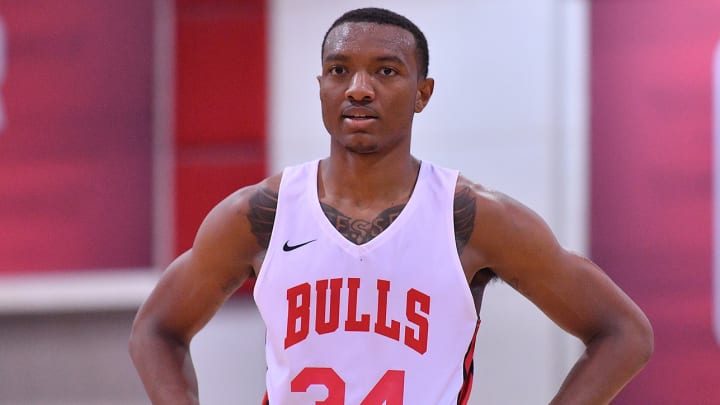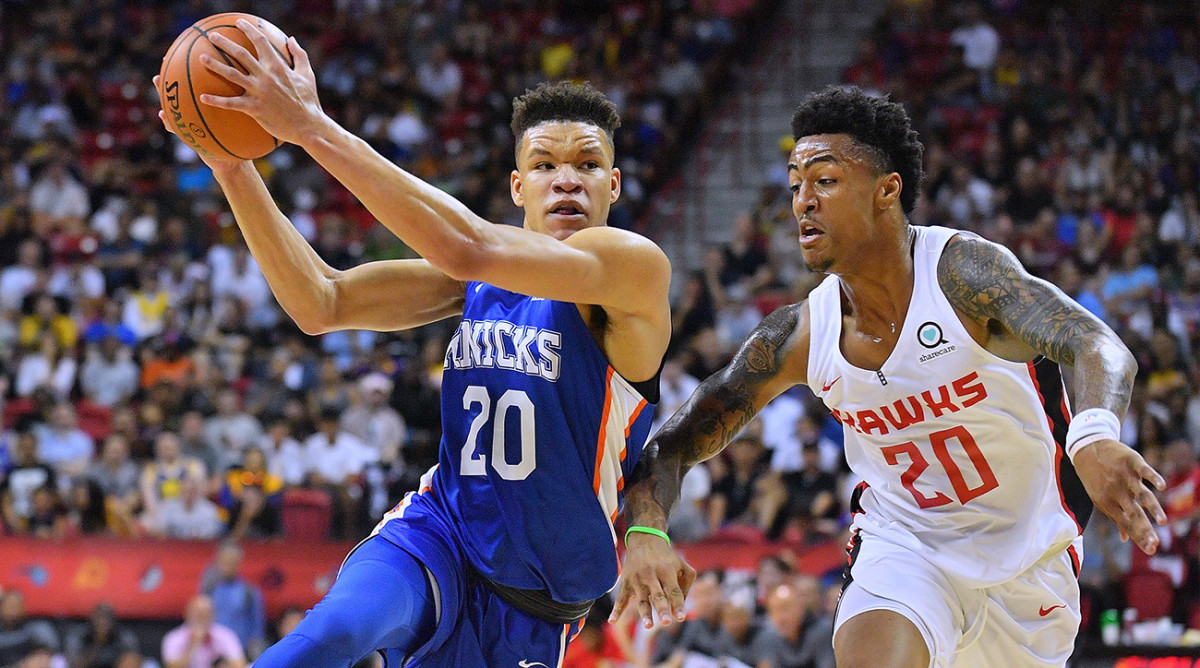Kevin Knox, Wendell Carter Jr. and Midsummer Hope for the Knicks and Bulls

The Knicks and Bulls have spent the better part of the past decade locked in a cold war to see who can alienate more lifelong fans. When they've succeeded, it's generally been in brutal fashion, grinding out wins, always with a clear ceiling on their success. When they've failed, it's been characterized by a special kind of maddening arrogance and prevailing incoherence. One minute Phil Jackson is denouncing the NBA's reliance on three-pointers about a month before the Warriors won their first title, and the next Chicago's brain trust is jettisoning broken down veterans to launch a new era with Rajon Rondo and Dwyane Wade.
Here we are in mid-July, though, and the strangest sensation is overtaking me. I think I might be excited about the Knicks and Bulls. I’m concerned about this, and it’s possible that I've watched too many 15-second Twitter highlights from summer league, but I can't help it.

The Bulls
For context's sake, let's review: This is the team that alienated Jimmy Butler just as he blossomed into a perennial All-NBA candidate, made a Godfather trade to land Doug McDermott, allegedly refused lucrative Butler trade offers when it was clear the team was headed nowhere, tried selling everyone on the Three Alphas era, traded for Cam Payne for some reason, and then abruptly dealt Butler on draft night last June.
In that Minnesota deal, the Bulls included their own first round pick (No. 16) despite widespread suspicions that Thibs would've done the deal regardless. They also took back Kris Dunn, a former No. 5 pick coming off a deeply underwhelming rookie season. Then they drafted Lauri Markkanen, a player they'd never worked out or interviewed. In the aftermath of the Butler trade, John Paxson announced that Chicago had "set a direction" to rebuild. Of course, in addition to giving away the extra first—might have been helpful to the rebuilding effort!—the team sold its second-round pick to Golden State, allowing the Warriors to steal Jordan Bell. Then, last season, their new-direction rebuilding efforts were stymied by a midseason hot streak that left them on the outside of the tanking race, ultimately forcing them to settle for the seventh pick in the draft.
Rookie Report Cards: The Most Noteworthy Summer League Showings
And yet... This plan is working? Markkanen deserves a ton of credit. Coming into last year's draft, there were so many people telling the world he wasn't Dirk or Porzingis that eventually everyone convinced themselves he was Channing Frye. Beginning with last year's Eurobasket championships and continuing through the regular season, he was worlds better than anyone expected (including the Bulls). He can score at every level, he's more athletic than he showed at Arizona, and while he was overshadowed by rookie peers like Jayson Tatum and Donovan Mitchell last season, he's got as much upside as any of them.
Now they've added Wendell Carter, Jr., who may have been the most impressive rookie at Las Vegas Summer League. Even if it's too early to make dramatic conclusions in any direction after a few games, the biggest questions Carter faced coming into the league were rooted in athleticism and his ability to defend at the next level. He played in a zone at Duke, and his lateral movement didn't look great. He has always been super skilled and intelligent offensively—Al Horford-ish—but for all his upside on offense, there were valid questions about how his defense would fit next to Markkanen. In Vegas, he moved better than he had all year at Duke. He switched well on the perimeter. He blocked shots. He was in much better shape. It's a really good sign. If Carter's defense is real, he becomes a near-perfect puzzle piece to slide next to Markkanen on both ends of the floor.
Now, did the Bulls overpay Zach LaVine once the Kings forced their hand? Definitely. $19.5 million a year is a lot of money, and LaVine is a streaky, inefficient scorer who plays absolutely no defense. He's only 23 years old and he can improve, but he's a long way from realizing any kind of All-Star potential. At the moment, he may have more value as the secret weapon for one final tanking mission than a building block for the next Bulls contender. But the most important thing to know about the Bulls offseason is that LaVine hand-wringing is probably beside the point. The Bulls aren't trying to contend next year, and they will have money to spend regardless of what LaVine is paid. If Carter is as good as he’s looked in Vegas, and if Markkanen continues to break out next year, Chicago will be in good shape regardless.
The Knicks
Almost exactly a year ago, Knicks fans were just beginning to recover from a draft week full of Porzingis trade rumors and the departure of Phil Jackson when, a week into free agency, it was announced that the team had offered a four-year, $71 million deal to Tim Hardaway Jr. That signing was a sobering reality check for millions of people who had foolishly let their guard down. Hardaway was just good enough to make it harder for the Knicks to tank, but not good enough to make the Knicks into a reliable winner. As Hardaway described that contract later in the year, "At the end of the day, it’s not my fault. They came to me."
The Hardaway deal wasn't horrible on its own—not when graded on the Noah scale—but it was from the same family of half-baked ideas that have pervaded this franchise for 20 years. And speaking of the bigger picture: the past season saw this team jettison its president of basketball operations, fire its coach, spend senseless money in free agency, lose the franchise player to season-ending injury, send Joakim Noah into exile, and, like Chicago, tank-without-actually-tanking. And now, like Chicago, the Knicks seem to have stumbled into something resembling a solution.
Kevin Knox went ninth in June, and he's been nearly as impressive as Carter through the first week in Vegas. He's averaged 23.3 points and 7.3 rebounds through his first three games, and like Carter, he already looks worlds more comfortable in NBA space than he did in a college system. At 6'9" and 215 pounds with a 7-foot wingspan, he can make plays in the open court, he can switch on defense, and he's been better off the dribble than he ever was at Kentucky. His shooting has been uneven—he went 5-20 on Thursday night—but as his jumper becomes more reliable from the perimeter, he fits the mold of a two-way scoring wing that's currently the most valuable prototype in the league. As Celtics Summer League coach Jay Larranagha said this week, "[Knox] is what the future of the NBA is.”

The same "it's way too early to trust any of this" disclaimers apply to Knox just as they do to Carter, but the past week has been encouraging for the Knicks. In addition to Knox, second-round pick Mitchell Robinson has looked intriguing as a freakishly athletic center flashing potential all over the floor. While Knox came back to earth Thursday, Mitchell put 17 points on 8-10 shooting, 12 rebounds, and six blocks in 27 minutes. Even undrafted rookie Allonzo Trier, a bullying two-guard from Arizona, has been consistently productive and looks like he might turn into a steal on a two-way contract. None of these players will be home runs—probably not even Knox—but they represent the sort of understated successes that are typical of good teams, and never the Knicks.
This momentum comes amid a month of chatter about next year's free-agent possibilities. New York can create cap room for one max contract if the front office decides to stretch the remainder of Joakim Noah's (presumably untradeable) $19.3 million contract. If the front office can also find a way to offload deals for Hardaway Jr. and Courtney Lee, the Knicks could have space for two max players. And all of that potential flexibility precedes a summer that could see the following players hit the open market: Kawhi Leonard, Kyrie Irving, Kevin Durant, Jimmy Butler, Klay Thompson, Al Horford, Khris Middleton, Kemba Walker, Marc Gasol, DeMarcus Cousins, DeAndre Jordan, and Kevin Love. Which brings us to...
Grades: Isaiah Thomas Can Rejuvenate Career in Nuggets' Low-Risk Gamble
The Future
Given the market sizes of Chicago and New York, not to mention the rest of the news in the NBA this summer, it may be tempting to draw a parallel to the Lakers. L.A. was another destination franchise beset with dysfunction for most of the decade. Over the course of 12 months, the team became much smarter and more aggressive, and suddenly LeBron James is in L.A.
Particularly with the Knicks, that's the dream. The problem is that everything the Knicks have always believed about themselves as a franchise—immunity to rebuilding, dominant market that lures superstars, iconic history—is what’s actually true of the Lakers. This is why it's important to be very careful about jumping to conclusions when you’re looking at KD’s opt-out and watching Kevin Knox clips. One year after Magic Johnson and Jeannie Buss circled LeBron for 12 months and then actually signed him, it would be extremely on-brand for the Knicks to do the same thing with Kevin Durant and Kyrie Irving and then strikeout entirely in July.
The New York front office is already working to downplay free-agency expectations. As team president Steve Mills said this week, “Our goal is to build our team organically and around our young guys who were drafted by the team and to get better. Our situation happens to be we will have cap room. But that’s not the goal we set out." Whatever happens, the next 12 months of the Knicks will underscore exactly what the Lakers achieved the past year. LeBron chose L.A. because of the market but also the long-term flexibility the Lakers could sell, and in that respect the Knicks have work to do. It wasn't easy to move bad deals for Timofey Mozgov and Jordan Clarkson, and if New York wants to get serious next summer, it'll be just as tricky to move guys like Lee and Hardaway Jr.
The Summer League Leap: Second-Year Players Making an Impact in Las Vegas
In Chicago's case, they'll probably take a longer view regardless. Markkanen isn't as far along as pre-injury Porzingis, and Wendell Carter Jr. is still 19 years old. LaVine is an ongoing experiment in the backcourt, and so is Kris Dunn. Patience is the smart play. The Bulls will have lots of cap room to play with over the next few years. This year they can try to take on bad deals in exchange for assets and there will be free agency options in the coming years who make more sense than the stars of next summer. In the meantime the Bulls will be in the East, where a half-decent nucleus has a chance to do some things and make real progress without being smothered by teams full of All-NBA players every other night.
Most teams that spend several years in no-man's land take several years to recover. Think about Orlando, Sacramento, Memphis, Charlotte, or Phoenix. The advantage to playing a major market and being one of the league's marquee teams is the ability to manufacture momentum almost immediately. A few successful picks, some cap room, and suddenly the future begins to get interesting. If there's any connection to the Lakers, that's the parallel. The minute these teams begin moving in the right direction, everyone pays attention.
All of the above comes with mandatory summer league disclaimers, mid-lottery expectations for next season, knocking on wood on behalf of all Porzingis ligaments, and the reminder that either one of these teams could do something truly indefensible within the next eight months. But until then, Knox and Carter have been undeniably awesome in Vegas, and the next few years of the Bulls and Knicks are worth monitoring. That's more than anyone would have said a month ago.
